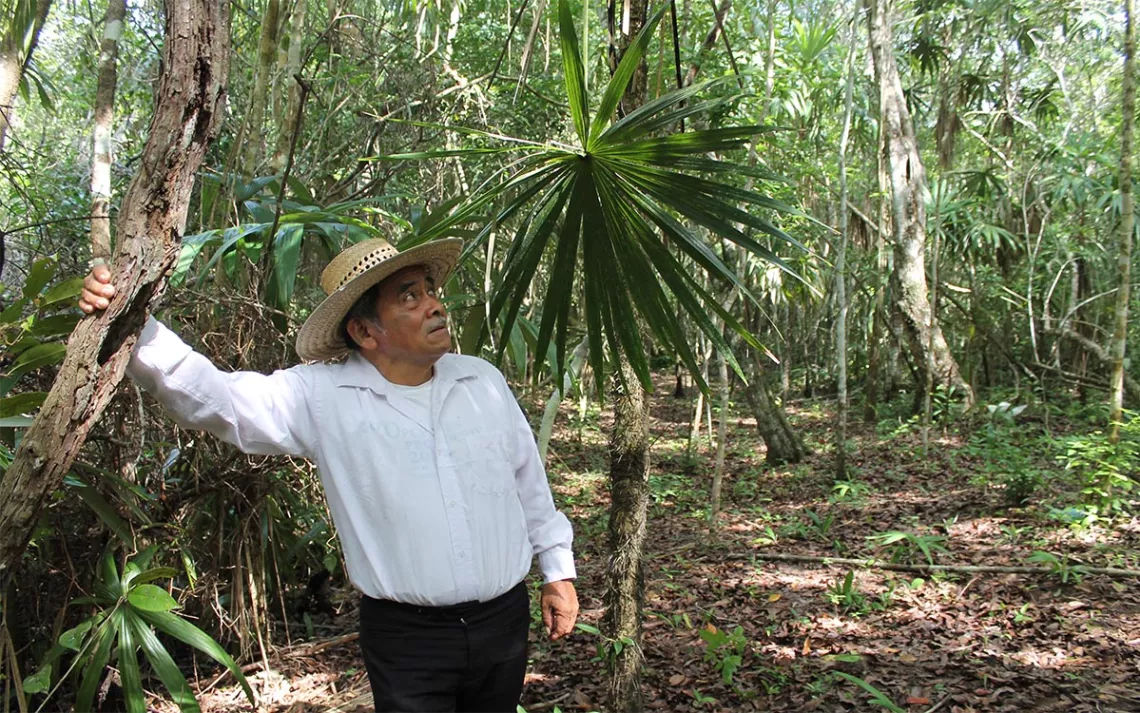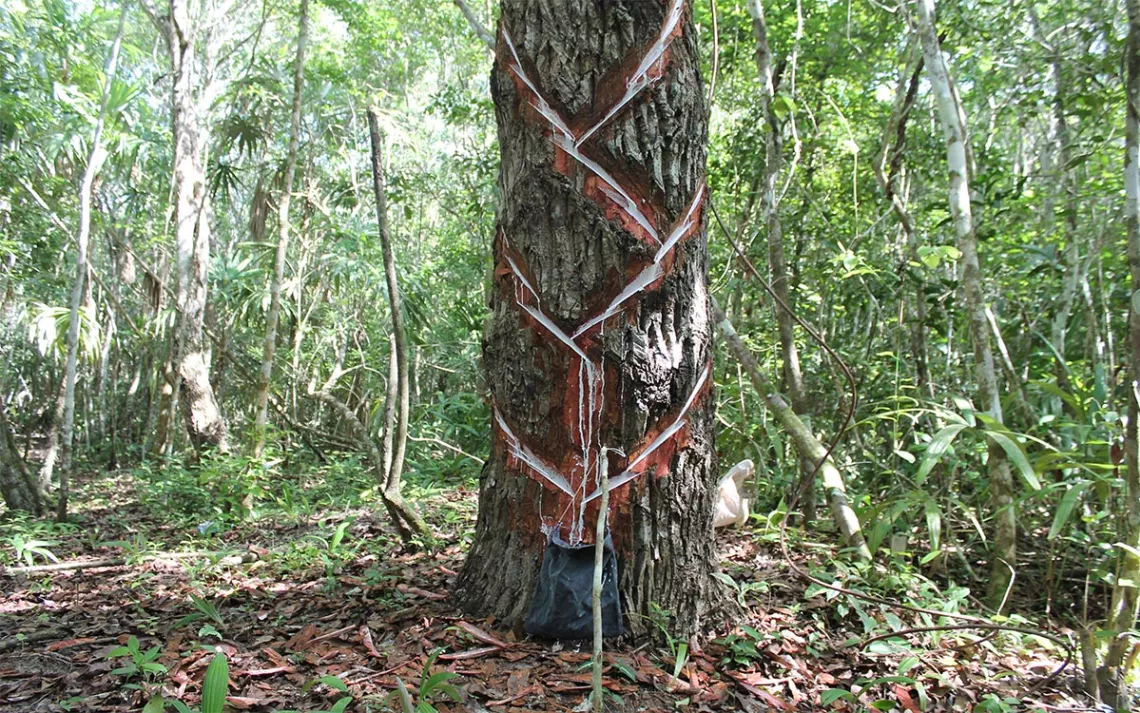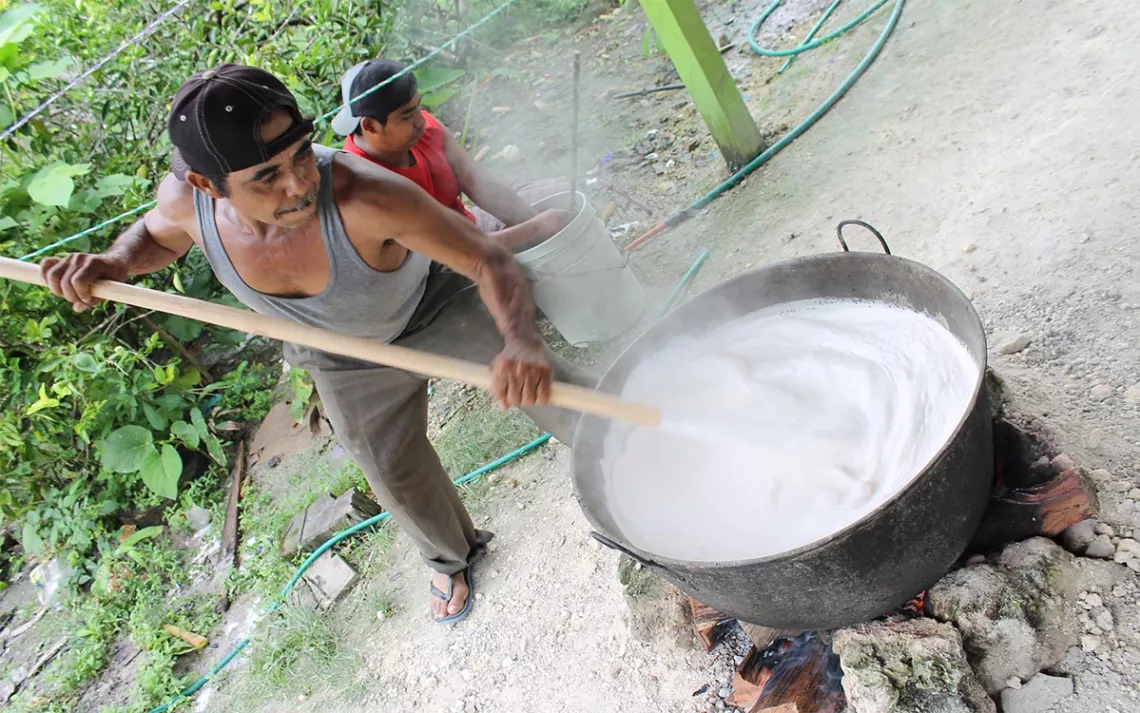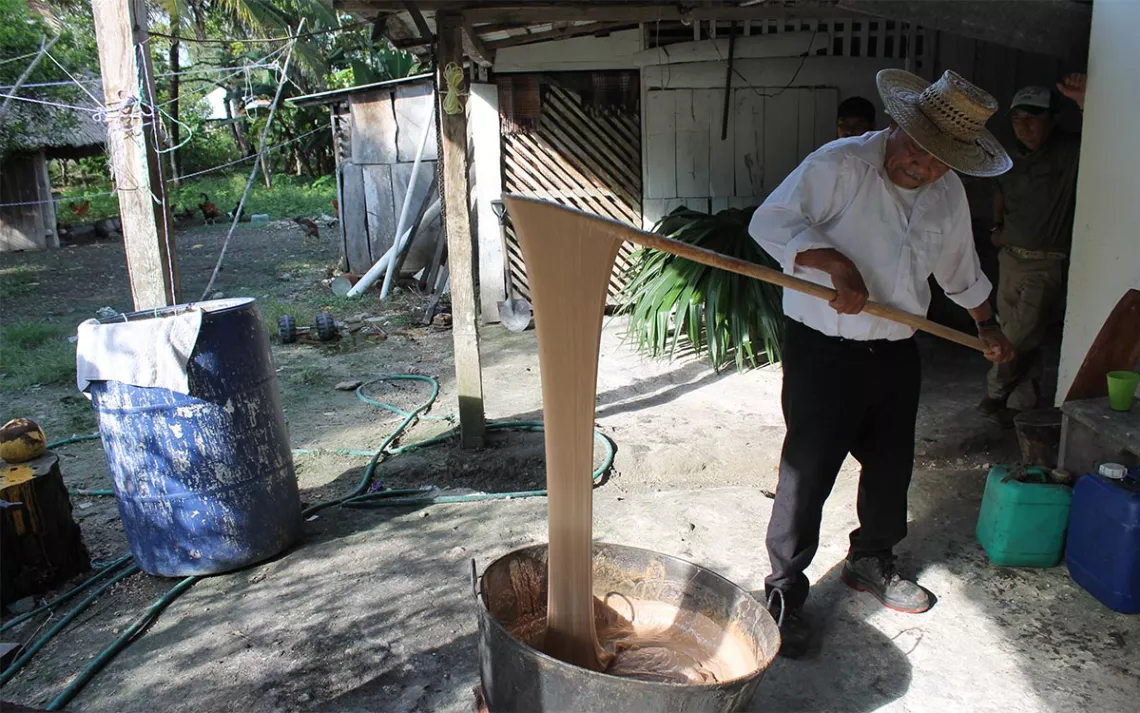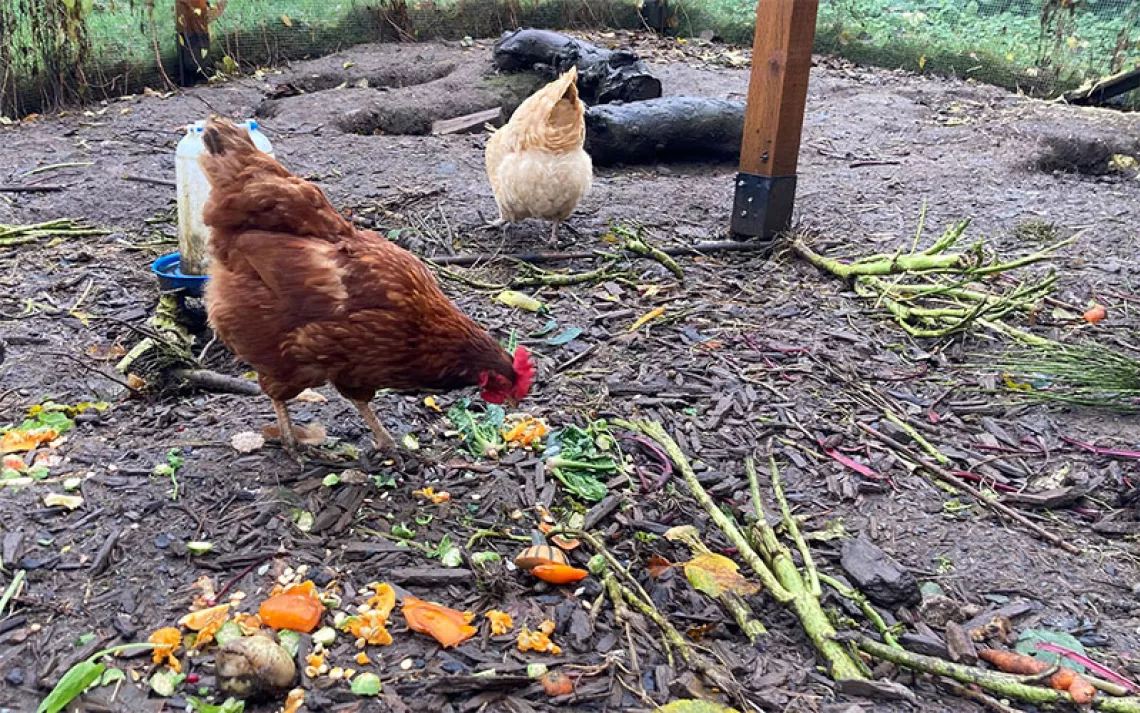Making Gum in the Mayan Rainforest
Chicleros continue an ancient tradition of producing and selling natural gum as competitors peddle the synthetic stuff
“I started working at 16,” Alfredo Ramírez says, as he sizes up the chicozapote tree in front of us. “I’m 56 now. That’s 40 years of harvesting chicle.”
Ramírez has led us off a gravel road and into the rainforest in Tres Garantías, Mexico. The chicozapote tree (Manilkara zapota) is over 50 feet tall, its upper branches disappearing out of sight into the forest canopy. Mosquitoes swarm around him, but Ramírez remains focused on the task at hand.
Here in Quintana Roo, in the southeast corner of Mexico, the sap of the chicozapote tree is perfect for chicle, or natural chewing gum, a product tracing back to the Mayan civilization.
“We can tell when the tree is ready to produce,” Ramírez says. “It takes around seven years after a harvest to produce the right kind of sap, and then we can harvest again.”
In other words, extracting the sap doesn’t permanently damage the tree, making this a sustainable way to make a living off the forest. The Yucatan Peninsula is a hot spot of deforestation in Mexico, due to pressures from palm oil, cattle ranching, and soy cultivation. Global Forest Watch found that in 2016, the three states making up the peninsula lost 95,000 hectares of forest. Chicle production allows local communities to preserve their forests while earning income.
Ramírez tightens a homemade harness around his waist and secures a sack at the base of the tree to collect the sap. His machete strikes the trunk, breaking away the bark to reveal bright-red wood underneath. A white substance begins oozing out: the sap that will be transformed into chewing gum. He gradually climbs up the tree, bracing his legs against the trunk. He works quickly and soon is 20 feet off the ground. His machete leaves behind diagonal cuts and the sap dripping down the tree.
Ramírez is a member of the Tres Garantías cooperative, which sells to the Chiclero Consortium, based in nearby Chetumal. The consortium will process the chicle into organic gum that will be exported to 30 countries. By maintaining this ancient tradition, Ramírez and other chicleros (natural gum producers) are helping to sustain local indigenous communities and the rainforest. When the Mayans ruled the Yucatan Peninsula, they extracted the sap of chicozapote and turned it into gum. The practice continued after the collapse of the Yucatecan Mayans in the ninth century.

Sign up to receive Sierra News & Views
Get articles like this one sent directly to your inbox weekly.
With this action you affirm you want to receive Sierra Club communications and may vote on policy designated by the Sierra Club Board.
Chicle was only consumed locally until Mexican general Antonio López de Santa Anna introduced it to American businessman Thomas Adams, who began importing it to the United States in the 1870s. Adams produced the first of many chewing-gum brands to follow. During World War II, gum was included in the rations of U.S soldiers, both increasing demand from U.S. companies and spreading the gospel of gum to new countries. In the early and middle 20th century, chicleros, organized in the Federation of Chicle Cooperatives, were the economic engine of the Yucatan Peninsula.
Gerardo Ramírez Aguilar, an agronomist from northern Mexico who is the production director of the Chiclero Consortium, says that during the peak years, 25,000 chicleros worked across the peninsula, and Mexico exported 6,300 tons of chicle a year. But the advent of synthetic gums in the 1950s precipitated a slow decline. Meanwhile, as part of agrarian reform, the federal government was giving property in the sparsely populated Calakmul rainforest to landless peasants. Tres Garantías is one of these communities created in the agrarian reform, known as ejidos, where land is owned cooperatively. The federal government designated the land for Tres Garantías in 1943, but there were no roads to reach the vast parcel of over 100,000 acres. Ejidatarios set up chicle camps in the rainforest, where they would live for weeks or months at a time. It was not until the 1970s that the ejidatarios began building homes and brought their families.
Ramírez got his start in the chicle camps. So did Raymundo Terrón Santana, who now serves as president of the Tres Garantías chicle cooperative and is one of the founders of the modern chicle industry.
By the 1980s, the Federation of Chicle Cooperatives had fallen into mismanagement. With the cooperatives in disarray, a long chain of middlemen took most of the profits, leaving the hard-working chicleros with only pesos for each kilogram. In 1993, Santana and Ramírez Aguilar were on the team that devised the Chicle Pilot Plan, a government program to reinvigorate the industry.
“[During the 1990s] we opened doors that used to be closed,” Ramírez Aguilar says, sitting in the air-conditioned offices of the Chiclero Consortium. Adjacent to the offices is the production plant that processes 10-kilogram bricks of chicle into packaged gum.
In 56 communities across the peninsula, over 600 chicleros, many of whom are indigenous Mayans, now sell to the consortium.
“We cut out the middlemen so a bigger portion of the profits would stay with the producer,” Ramírez Aguilar says. Today, 80 percent of the price per kilogram goes to the chiclero.
“We identified that there wasn’t a 100-percent natural chewing gum on the market,” Ramírez Aguilar says. They worked for years to develop Chicza, the only chewing gum made exclusively from chicle, instead of synthetics. Up until this point, chicle had only been exported as raw material. The other half of sales continues to be unprocessed chicle, which Japanese companies buy to produce chicle-synthetic gum mixes.
The first production plant opened in 2007, the same year they received organic certification. Chicza is sold in 30 countries around the world, with half of the sales in Germany alone. Chicza is sold in Mexico, but Ramírez Aguilar says the price point is a challenge to growing the Mexican market. He explains that because the chicozapote tree naturally regenerates its sap, chicle production is symbiotic with the ecosystem of the tropical rainforest. The consortium also runs a nursery to grow chicozapote trees to transplant in communities.
Ramírez Aguilar says proudly, “We are able to continually raise the prices we pay chicleros, and that incentivizes conservation of the rainforest.” But he says environmental regulations governing chicle are unnecessarily strict. Each community hires a technical advisor to draft a management plan, which is then approved by the state offices of the Environment and Natural Resources Secretariat (Semarnat). Chicle harvesting is forbidden within protected areas, such as the nearby Calakmul Biosphere Reserve. The Chiclero Consortium has advocated for these laws to be changed.
“The environmental authorities treat chicle like timber, an activity we have to limit, but they don’t understand that harvesting chicle doesn’t harm the rainforest,” he says.
The international forces driving the chicle market feel far removed in Tres Garantías, where Ramírez leads us to his simple home in town. His son, also named Alfredo Ramírez, lights a fire to cook down the sap into hard chicle. By noon it is 90 degrees out, and the humidity of the rainforest is stifling.
In a week of harvesting, Ramírez has collected 45 liters of chicle sap, which will cook down to about 30 kilograms of gum. The sap comes to a boil and begins to coagulate. Ramírez stirs vigorously with a long wooden pole, coaxing the liquid to the right consistency.
Santana looks on, wearing a broad straw hat to shield himself from the broiling midday sun. He reminisces about arriving to live in Tres Garantías, back before there was a highway, in the days when middlemen took most of the profits.
After three hours of stirring, the chicle is finally ready. The piping-hot, gray gum must cool before being molded into the 10-kilogram bricks that will be sent to Chetumal. Ramírez lathers up his hands with soap so that the chicle will not stick. Ramírez will deliver the bricks, his first batch of the season, to the Tres Garantías cooperative, where he will be paid a little over $4 for each kilo. The work of Ramírez and other chicleros might seem like a tiny contribution to the global gum market, but producing and selling natural gum in a sea of competitors selling synthetics has been a monumental feat, one that represents a tradition going back thousands of years to their Mayan ancestors.
Market forces and over-regulation pose challenges for the chicle industry. But despite the odds, the local cooperatives and the consortium have succeeded in securing a future for the chicleros of the Yucatan Peninsula.
Travel for this story was funded by a grant from the Solutions Journalism Network.
 The Magazine of The Sierra Club
The Magazine of The Sierra Club

